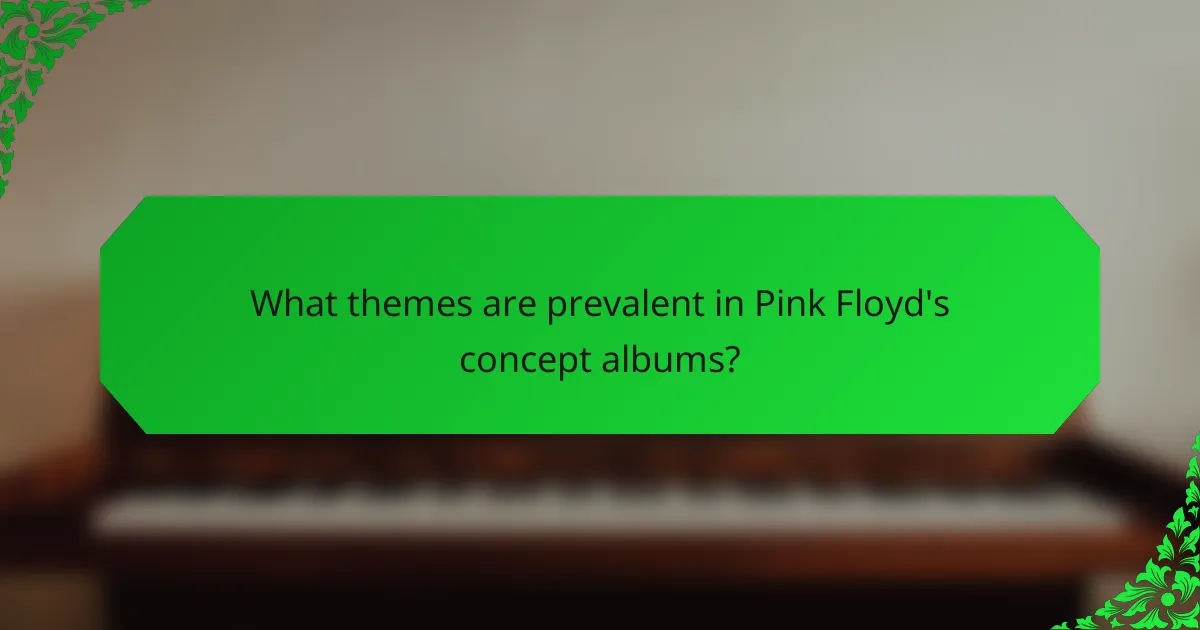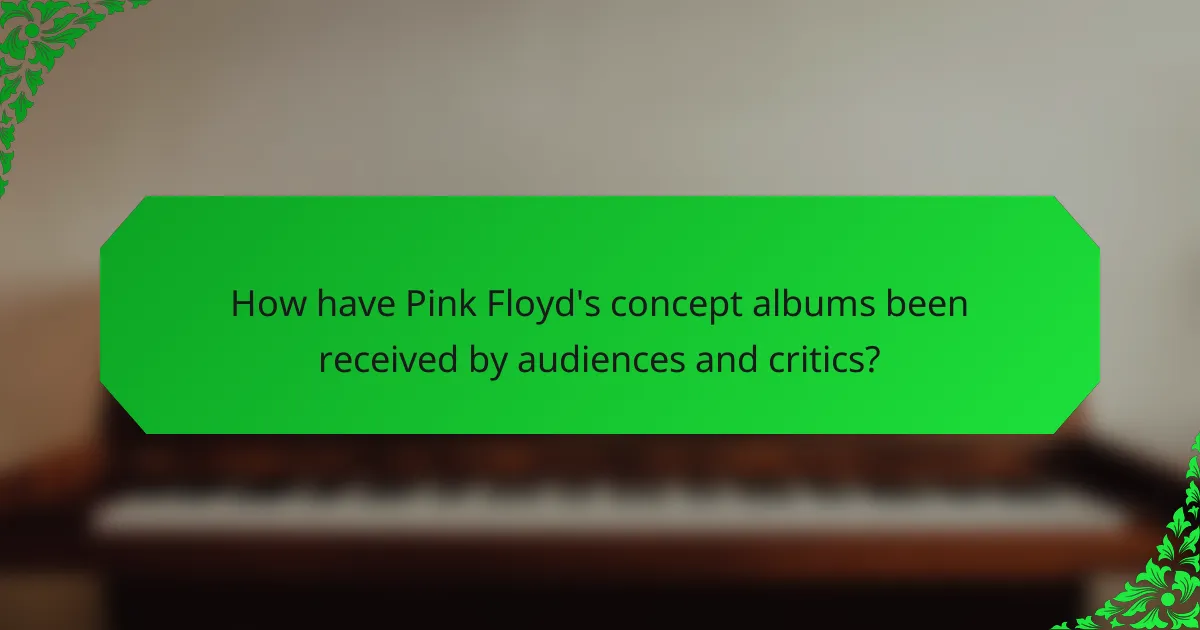The article analyzes Pink Floyd’s concept albums, which include “The Dark Side of the Moon,” “Wish You Were Here,” “Animals,” “The Wall,” and “The Final Cut.” It examines the narrative structures employed in these albums, such as linear storytelling and cyclical themes, as well as character development, particularly in “The Wall.” The prevalent themes of alienation, mental illness, and societal critique are also discussed, highlighting how these elements enhance the emotional depth of the music. Additionally, the article reviews the critical and commercial reception of these albums, noting their significant impact on progressive rock and their enduring popularity among audiences and critics alike.

What are the Concept Albums of Pink Floyd?
Pink Floyd’s concept albums include “The Dark Side of the Moon,” “Wish You Were Here,” “Animals,” “The Wall,” and “The Final Cut.” “The Dark Side of the Moon,” released in 1973, explores themes of mental illness and the human experience. “Wish You Were Here,” released in 1975, reflects on absence and alienation. “Animals,” released in 1977, critiques societal structures using animal metaphors. “The Wall,” released in 1979, tells a narrative of isolation and personal trauma. “The Final Cut,” released in 1983, addresses war and loss. Each album is recognized for its cohesive themes and narrative structures, solidifying Pink Floyd’s legacy in progressive rock.
How did Pink Floyd define the concept album format?
Pink Floyd defined the concept album format through cohesive storytelling across multiple tracks. Their albums often explore complex themes such as mental health, societal issues, and personal experiences. For example, “The Dark Side of the Moon” integrates songs into a continuous narrative about the human experience. Each track transitions smoothly into the next, creating an immersive listening experience. The band emphasized thematic unity, making the entire album a singular artistic statement. This approach influenced many artists and solidified the concept album as a legitimate art form in popular music.
What are the key characteristics of a concept album?
A concept album is a musical work that tells a cohesive story or explores a specific theme throughout its tracks. Each song typically contributes to an overarching narrative or concept. The album often includes recurring musical motifs or themes that unify the songs. Concept albums frequently feature elaborate lyrics that delve into complex ideas or emotions. They may incorporate interludes or transitions that enhance the storytelling experience. Many concept albums are designed to be listened to in sequence, rather than as standalone tracks. Historically, notable examples include Pink Floyd’s “The Wall” and “Dark Side of the Moon,” which exemplify these characteristics through their intricate narratives and thematic depth.
How does Pink Floyd’s approach differ from other artists?
Pink Floyd’s approach to music is distinct due to their emphasis on concept albums. Their works often explore complex themes such as existentialism and mental health. Unlike many artists, they prioritize narrative coherence throughout their albums. This storytelling aspect creates a unified listening experience.
For example, “The Dark Side of the Moon” addresses the pressures of life and mental illness. The seamless transitions between tracks enhance the thematic depth. Additionally, their use of innovative sound design sets them apart. They incorporate experimental techniques and elaborate production. This results in a rich auditory landscape not commonly found in mainstream music.
Overall, Pink Floyd’s focus on thematic exploration and cohesive storytelling differentiates them from other artists in the music industry.
What are the notable concept albums created by Pink Floyd?
The notable concept albums created by Pink Floyd include “The Dark Side of the Moon,” “Wish You Were Here,” “Animals,” “The Wall,” and “The Final Cut.” “The Dark Side of the Moon,” released in 1973, explores themes of mental illness and existentialism. It is renowned for its innovative use of studio effects and cohesive narrative. “Wish You Were Here,” released in 1975, pays tribute to former band member Syd Barrett. It addresses themes of absence and disillusionment. “Animals,” released in 1977, critiques capitalism through allegorical representations of different societal classes. “The Wall,” released in 1979, tells the story of a rock star’s isolation and alienation. It features a rock opera format and is one of the band’s most commercially successful works. “The Final Cut,” released in 1983, serves as a commentary on war and loss, often considered a continuation of “The Wall.” Each album is recognized for its thematic depth and musical innovation, solidifying Pink Floyd’s legacy in rock music.
What themes are explored in ‘The Dark Side of the Moon’?
‘The Dark Side of the Moon’ explores themes of mental illness, existentialism, and the passage of time. The album addresses the struggles of life and the pressures of modern society. It delves into the effects of stress and the human condition. The concept of mortality is a significant theme throughout the work. Additionally, the album examines the conflict between personal desires and societal expectations. These themes are conveyed through the lyrics and musical composition. The use of sound effects enhances the exploration of these themes. Overall, the album presents a profound commentary on human experience and consciousness.
How does ‘The Wall’ convey its narrative structure?
‘The Wall’ conveys its narrative structure through a combination of storytelling and music. The album follows the journey of Pink, a character representing the struggles of isolation and trauma. It employs a rock opera format, integrating songs that reflect Pink’s emotional state. Each track serves as a chapter, advancing the narrative arc. The use of recurring motifs, such as the metaphor of the wall, reinforces the themes of alienation. Additionally, spoken word segments and sound effects enhance the storytelling experience. The narrative culminates in a dramatic climax, showcasing Pink’s breakdown. This structure allows listeners to engage deeply with the character’s psychological journey.
What unique attributes are present in ‘Wish You Were Here’?
The unique attributes present in ‘Wish You Were Here’ include its thematic exploration of absence and alienation. The album reflects on the music industry and personal disconnection. It features a distinct blend of progressive rock and acoustic elements. The title track is notable for its emotional depth and poignant lyrics. The album also includes a tribute to former band member Syd Barrett. Its structure is cohesive, with tracks flowing seamlessly into one another. The use of sound effects, such as the radio static in “Shine On You Crazy Diamond,” enhances its narrative. ‘Wish You Were Here’ is recognized for its critical acclaim and enduring influence in music history.

What narrative structures are employed in Pink Floyd’s concept albums?
Pink Floyd’s concept albums employ several narrative structures, including linear storytelling, cyclical themes, and character development. Linear storytelling is evident in “The Wall,” which follows the protagonist Pink’s descent into isolation. Cyclical themes appear in “Dark Side of the Moon,” where the narrative returns to key motifs, emphasizing the passage of time and human experience. Character development is central to “The Wall,” illustrating Pink’s transformation through various life events. These structures enhance the emotional impact and thematic depth of the albums. The use of these narrative techniques contributes to the overall cohesion and artistic vision of Pink Floyd’s work.
How do narrative techniques enhance the storytelling in these albums?
Narrative techniques enhance storytelling in Pink Floyd’s albums by creating immersive experiences. These techniques include thematic continuity, character development, and symbolic imagery. Thematic continuity allows listeners to engage with overarching concepts, such as alienation and existentialism. Character development provides relatable figures, making emotional connections stronger. Symbolic imagery enriches the narrative, offering layers of meaning that invite interpretation. For example, in “The Wall,” the protagonist’s journey reflects personal and societal struggles. This deepens the listener’s engagement and understanding. Overall, these techniques transform music into a compelling narrative experience.
What role does character development play in the narratives?
Character development is crucial in narratives as it drives emotional engagement and plot progression. In Pink Floyd’s concept albums, characters often embody complex themes and struggles. For example, in “The Wall,” the protagonist’s evolution reflects isolation and psychological trauma. This character arc enhances the listener’s connection to the music. It allows for a deeper exploration of themes such as alienation and societal pressures. The transformation of characters is essential for conveying the overarching messages of the albums. Overall, character development serves as a vehicle for thematic expression and audience immersion.
How is the concept of time represented in the narratives?
The concept of time in Pink Floyd’s narratives is represented as a fluid and often distorted experience. Time is depicted as a relentless force that impacts human existence and perception. In albums like “The Dark Side of the Moon,” time is illustrated through themes of aging, mortality, and the passage of life. The track “Time” exemplifies this by using ticking clocks and alarms to signify urgency and the inevitability of time passing. Additionally, the narrative structure often reflects non-linear storytelling, emphasizing memories and reflections rather than chronological progression. This approach allows listeners to engage with time on a more emotional and philosophical level. The use of soundscapes, such as echoes and fades, further enhances this representation, creating a sense of timelessness or cyclical nature. Overall, Pink Floyd’s narratives invite contemplation on how time shapes human experiences and consciousness.
In what ways do musical elements contribute to the narrative?
Musical elements contribute to the narrative by enhancing emotional depth and storytelling. They create atmosphere and set the tone for the listener. For example, orchestration can evoke feelings of tension or tranquility. The use of motifs helps to establish character themes and emotional arcs. Changes in tempo can reflect shifts in narrative pace or mood. Lyrics often provide context and drive the storyline forward. Instrumental sections can signify transitions between scenes or ideas. In Pink Floyd’s albums, these elements work together to create a cohesive narrative experience. The interplay between music and lyrics deepens audience engagement and understanding of the story being told.
How do lyrics shape the listener’s understanding of the story?
Lyrics shape the listener’s understanding of the story by providing context and emotional depth. They convey themes that are central to the narrative. The choice of words influences the listener’s interpretation. Imagery in lyrics paints vivid scenes for the audience. Metaphors and symbolism add layers of meaning. For example, Pink Floyd’s “The Wall” uses lyrics to explore isolation and trauma. Each song builds on the overarching narrative, guiding listeners through the storyline. This structured approach helps listeners connect with characters and situations. As a result, the lyrics enhance the overall storytelling experience.
What significance do musical motifs have throughout the albums?
Musical motifs in Pink Floyd’s albums serve as thematic anchors and narrative devices. They help unify the albums by creating a sense of continuity. Repeated motifs can evoke specific emotions or ideas tied to the overarching narrative. For example, the motif of the “clock” in “Time” symbolizes the passage of time and mortality. This motif recurs throughout “The Dark Side of the Moon,” reinforcing its central themes. Additionally, motifs can signal transitions between different sections of an album. They guide listeners through the evolving musical landscape. This intentional use of motifs enhances the overall listening experience and deepens the narrative impact.

What themes are prevalent in Pink Floyd’s concept albums?
Prevalent themes in Pink Floyd’s concept albums include alienation, mental illness, and the passage of time. The band often explores the human experience and existentialism. For instance, “The Wall” addresses the isolation and trauma of the protagonist. “Dark Side of the Moon” delves into the pressures of life and the inevitability of death. Additionally, themes of war and societal critique are prominent in “The Final Cut.” The use of soundscapes and lyrics enhances these themes, creating a cohesive narrative throughout their albums. The combination of music and thematic depth has established Pink Floyd as a seminal force in progressive rock.
How do existential themes manifest in their work?
Existential themes manifest in Pink Floyd’s work through exploration of isolation, identity, and the human condition. The album “The Wall” illustrates alienation with its narrative of a protagonist building emotional walls. Songs like “Comfortably Numb” depict disconnection from reality and self. In “Dark Side of the Moon,” the lyrics reflect on time, madness, and existential dread. The use of soundscapes enhances feelings of existential anxiety. Their music often questions the meaning of life and the inevitability of death. Pink Floyd’s artistic choices convey a deep sense of existential inquiry, resonating with listeners on a profound level.
What is the significance of mental health in Pink Floyd’s albums?
Mental health is a central theme in Pink Floyd’s albums. The band explores psychological struggles through their music and lyrics. Notable albums like “The Dark Side of the Moon” and “The Wall” delve into issues such as anxiety, depression, and isolation. “The Dark Side of the Moon” addresses the pressures of life and mental breakdowns. “The Wall” narrates the story of a character dealing with trauma and alienation. The lyrics reflect personal experiences, particularly Roger Waters’ struggles. This focus on mental health resonates with listeners, making the albums impactful. The exploration of these themes has contributed to Pink Floyd’s legacy in rock music.
How do societal critiques appear in their narratives?
Societal critiques in Pink Floyd’s narratives manifest through themes of alienation and criticism of authority. The band’s lyrics often highlight issues such as war, capitalism, and mental health. For instance, “The Wall” addresses the psychological impact of societal pressures. The album critiques the education system and parental influence, portraying them as oppressive forces. Additionally, “Animals” uses animal metaphors to comment on class divisions and corporate greed. The narrative structure supports these critiques by weaving personal stories with broader social commentary. This approach allows listeners to connect emotionally with the critique while reflecting on societal issues.
What emotional responses do these themes evoke in listeners?
The themes in Pink Floyd’s concept albums evoke a range of emotional responses in listeners. These themes often explore existentialism, alienation, and human experience. The exploration of such profound topics can lead to feelings of introspection and melancholy. Listeners may feel a sense of nostalgia when reflecting on personal experiences related to the music. The use of soundscapes and lyrics can also elicit feelings of anxiety and despair. Additionally, themes of hope and resilience can inspire motivation and upliftment. Research indicates that music can significantly influence emotions, with studies showing that specific musical elements can trigger emotional responses. For example, a study by Juslin and Västfjäll (2008) found that music can evoke strong emotions through mechanisms such as memory retrieval and emotional contagion.
How do personal experiences influence listener interpretations?
Personal experiences significantly influence listener interpretations of music. Each listener brings unique backgrounds, emotions, and memories to their engagement with a song or album. These factors shape how they perceive lyrics, melodies, and themes. For example, a listener who has faced loss may interpret a song about grief more deeply than someone without that experience. Research indicates that emotional connections enhance memory retention and understanding of music. A study by Janata et al. (2007) found that personal relevance increases emotional response to music. Thus, individual experiences create diverse interpretations, making music a highly subjective art form.
What role does nostalgia play in the reception of their music?
Nostalgia significantly enhances the reception of Pink Floyd’s music. Their albums evoke memories of personal and collective experiences. This emotional connection makes their themes more relatable and impactful. For many listeners, Pink Floyd’s music serves as a soundtrack to pivotal moments in life. The band’s use of soundscapes and lyrical depth often triggers nostalgic feelings. Research shows that nostalgia can increase emotional engagement with music. A study by Wildschut et al. (2006) indicates that nostalgic music can enhance mood and foster social connectedness. This emotional resonance contributes to the enduring popularity of Pink Floyd’s work.

How have Pink Floyd’s concept albums been received by audiences and critics?
Pink Floyd’s concept albums have been widely acclaimed by both audiences and critics. Albums like “The Dark Side of the Moon” and “The Wall” are often regarded as masterpieces. “The Dark Side of the Moon” spent 937 weeks on the Billboard 200 chart, showcasing its immense popularity. Critics frequently praise the thematic depth and innovative soundscapes of these albums. For instance, Rolling Stone magazine has consistently ranked “The Wall” among the greatest albums of all time. Audience reception is also reflected in high sales figures, with “The Dark Side of the Moon” selling over 45 million copies worldwide. Overall, Pink Floyd’s concept albums are celebrated for their artistic ambition and cultural impact.
What impact did these albums have on the music industry?
Pink Floyd’s concept albums significantly transformed the music industry. They pioneered the use of cohesive narratives in albums, elevating the album format beyond mere collections of songs. Their work influenced the progressive rock genre, encouraging other artists to explore complex themes and structures. The band’s innovative use of studio technology set new standards for sound production and album artistry. Albums like “The Dark Side of the Moon” achieved unprecedented commercial success, spending over 900 weeks on the Billboard 200 chart. This success demonstrated the potential for albums to be both artistic expressions and commercial products. Pink Floyd’s influence is evident in the work of numerous artists across various genres, shaping the evolution of rock music and beyond. Their legacy continues to inspire musicians and producers to this day.
How did critics initially respond to Pink Floyd’s concept albums?
Critics initially responded to Pink Floyd’s concept albums with a mix of admiration and skepticism. Many praised the band’s innovative approach to music and storytelling. They highlighted the seamless integration of themes and soundscapes. However, some critics found the albums overly ambitious or pretentious. For instance, “The Dark Side of the Moon” received acclaim for its production and lyrical depth. In contrast, “The Wall” faced mixed reviews for its narrative complexity. Overall, the initial reception varied, reflecting both appreciation and critique of Pink Floyd’s artistic vision.
What has been the evolution of audience reception over time?
Audience reception of Pink Floyd’s concept albums has evolved significantly over time. Initially, their albums received mixed reviews, often praised for innovation but criticized for complexity. As time passed, audience appreciation grew. Albums like “The Dark Side of the Moon” became iconic, achieving commercial success and critical acclaim. This shift is evidenced by the album’s continuous presence on charts since its release in 1973.
In the 1980s and 1990s, retrospective reviews highlighted the band’s influence on progressive rock and art rock genres. Modern audiences often engage with Pink Floyd’s work through digital platforms, leading to renewed interest among younger listeners. Streaming services have made their music more accessible, further broadening their audience.
Overall, audience reception has transitioned from initial skepticism to widespread acclaim, reflecting both cultural shifts and advancements in music consumption.
What legacy do Pink Floyd’s concept albums leave behind?
Pink Floyd’s concept albums leave a profound legacy in the music industry. They are known for their innovative storytelling and thematic depth. Albums like “The Dark Side of the Moon” and “The Wall” explore complex issues such as mental health and societal alienation. These works have influenced countless artists across various genres. Pink Floyd’s use of soundscapes and progressive rock elements set new standards for album production. Their albums often challenge conventional song structures, creating a cohesive narrative experience. This approach has inspired the concept album format in modern music. The band’s artistic vision has solidified their status as pioneers in rock music.
How have they influenced contemporary artists and genres?
Pink Floyd has significantly influenced contemporary artists and genres through their innovative approach to music and storytelling. Their concept albums, such as “The Dark Side of the Moon,” integrated complex narratives and themes, setting a standard for artistic depth in rock music. This approach has inspired numerous artists across various genres, including progressive rock, alternative rock, and electronic music.
For instance, bands like Radiohead and Muse have cited Pink Floyd as a major influence in their own conceptual and atmospheric music. Additionally, the use of soundscapes and studio effects pioneered by Pink Floyd has shaped the production techniques in modern music. Their emphasis on thematic coherence in albums has led to a resurgence of the album format in contemporary music, encouraging artists to explore narrative structures within their work.
The impact of Pink Floyd can be seen in the way contemporary artists prioritize artistic expression and thematic exploration, reinforcing their legacy in the music industry.
What lessons can be learned from Pink Floyd’s approach to concept albums?
Pink Floyd’s approach to concept albums teaches the importance of cohesive storytelling. Their albums, like “The Wall,” create a unified narrative that engages listeners. This narrative structure enhances emotional connection and depth. The use of recurring themes, such as alienation and introspection, reinforces the overall message. Additionally, their innovative soundscapes and production techniques elevate the listening experience. The integration of visual elements, like album art and live performances, creates a multi-sensory experience. These strategies demonstrate how to effectively blend music and narrative for greater impact. Overall, Pink Floyd exemplifies the power of artistic vision in album creation.
What are some best practices for analyzing concept albums?
Best practices for analyzing concept albums include understanding the narrative structure, identifying recurring themes, and examining the album’s reception. First, a clear narrative structure often guides the listener through a story or concept. This structure can be linear or non-linear, influencing how the music is experienced. Second, identifying themes such as love, loss, or societal issues enriches the analysis. Themes often reflect the artist’s intentions and cultural context. Third, examining the reception provides insight into how audiences and critics interpret the work. Critical reviews and fan responses can highlight the album’s impact and significance. These practices collectively enhance the understanding of a concept album’s artistic depth.
How can one effectively interpret the themes and narratives?
To effectively interpret the themes and narratives, one should first identify the central concepts within the work. Analyzing lyrics, music composition, and album artwork reveals deeper meanings. Contextualizing the album within its historical and cultural background enhances understanding. Engaging with interviews and critiques from the artists provides additional insights. Listening attentively to the musical elements helps in grasping emotional undertones. Comparing the album with other works by the same artist can highlight recurring themes. Utilizing scholarly analyses can offer structured interpretations. These methods collectively facilitate a comprehensive understanding of the themes and narratives present in Pink Floyd’s concept albums.
What resources are available for deeper understanding of Pink Floyd’s work?
Books such as “Comfortably Numb: The Inside Story of Pink Floyd” by Mark Blake provide in-depth insights. Documentaries like “Pink Floyd: The Story of Wish You Were Here” explore their creative process. Websites such as the official Pink Floyd site offer extensive discographies and interviews. Academic journals often publish analyses of their concept albums. Resources like fan forums and social media groups facilitate discussions among enthusiasts. Listening to their albums with critical reviews enhances understanding of themes. Concert recordings and live performances illustrate their narrative style. These resources collectively deepen comprehension of Pink Floyd’s artistic contributions.
The main entity of the article is Pink Floyd’s concept albums, which include notable works such as “The Dark Side of the Moon,” “Wish You Were Here,” “Animals,” “The Wall,” and “The Final Cut.” The article analyzes the narrative structures, prevalent themes, and audience reception of these albums, highlighting their exploration of complex issues such as mental health, societal critique, and existentialism. It discusses how Pink Floyd defined the concept album format through cohesive storytelling and innovative sound design, and examines the emotional responses these themes evoke in listeners. Additionally, the article addresses the legacy and influence of Pink Floyd’s work on contemporary music and offers best practices for analyzing concept albums.
